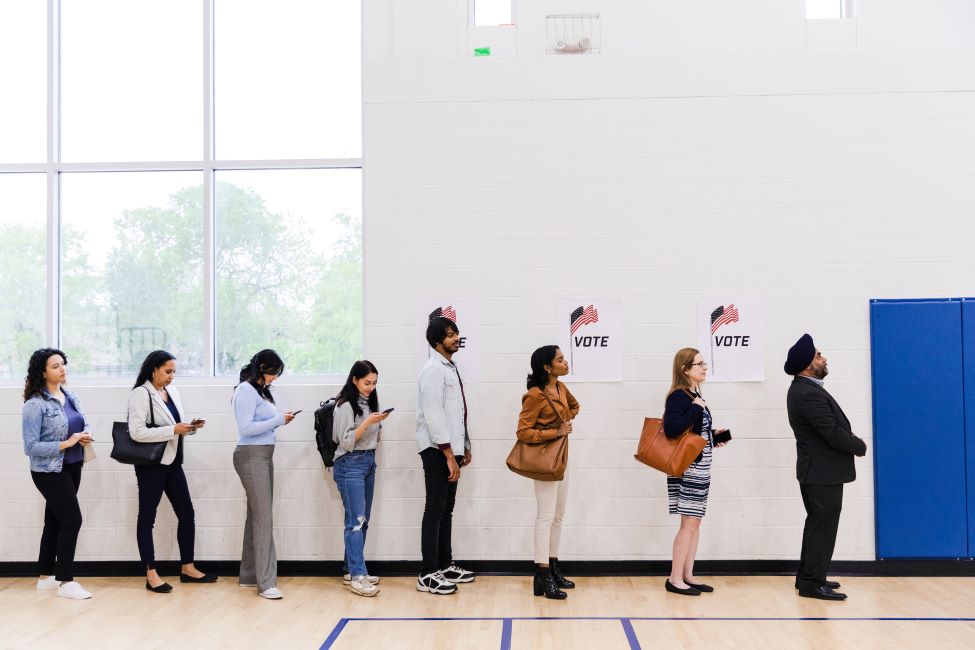FAU Poll: Presidential Race Tightens Across Key Battleground States

Voters across the United States are about to decide the future of the country.
The latest polls from the Florida Atlantic University Political Communication and Public Opinion Research Lab ( PolCom Lab ) and MainStreet Research reveal a highly competitive landscape in the battleground states of Michigan, Pennsylvania and Wisconsin, with both the presidential and U.S. Senate races showing narrow Democratic leads. U.S. Vice President Kamala Harris and Democratic Senate candidates hold slight edges, but with numbers within the margin of error, these races could swing either way in the final stretch.
Pennsylvania: Harris and Casey Leading but Vulnerable
In Pennsylvania, Harris leads former U.S. President Donald Trump by two points among likely voters, with Harris at 49% and Trump at 47%, while 1% choose another candidate, and 2% remain undecided. Harris holds a six-point advantage among women (51% to 45%), while Trump has a slight edge with men, leading 50% to 48%.
Harris also has a small lead among voters aged 18-49 at 49% to 45%, while the race is extremely close among those 50 and older, with Harris at 50% and Trump at 49%.
The U.S. Senate race in Pennsylvania shows Democratic incumbent Sen. Bob Casey with a five-point lead over Republican David McCormick, 49% to 44%, with 1% choosing another candidate and 6% undecided. Casey performs well among women, who favor him 51% to 40%, while he and McCormick are tied among men at 48%. Casey leads significantly among Black voters (74% to 4%) and white college graduates (56% to 42%), while McCormick leads among white non-college voters (54% to 40%).
“Pennsylvania’s gender and education divides are significant, reflecting the challenges candidates have faced in building broad coalitions,” said Luzmarina Garcia, Ph.D., assistant professor of political science at FAU.
Wisconsin: Close Contests in Presidential and US Senate Races
In Wisconsin, Harris and Trump are neck-and-neck, with Harris at 49% and Trump just behind at 48%, with 2% undecided. Harris leads among women by a significant margin, 54% to 43%, but Trump maintains an advantage among men, 53% to 43%. Harris also holds a strong lead among white college graduates (58% to 39%), while Trump leads among white non-college voters (55% to 42%).
In the U.S. Senate race, Democrat Tammy Baldwin has a narrow two-point lead over Republican Eric Hovde, (47% to 45%). Baldwin performs better with those aged 50 and older, leading 51% to 47%, while Hovde has a slight edge among 18–49-year-olds, 43% to 42%.
“Our data show party loyalty remains a powerful force, but with margins this close, split-ticket voting could be pivotal,” said Kevin Wagner, Ph.D., professor of political science and co-director of the PolCom Lab.
Michigan: Harris and Slotkin Hold Small Leads
In Michigan, Harris holds a narrow advantage over Trump at 49% to 47%, with 2% choosing another candidate and 3% undecided. Harris leads with white college graduates (51% to 45%), while Trump dominates among white non-college voters (55% to 41%). The U.S. Senate race shows Democrat Elissa Slotkin with a lead over Republican Mike Rogers, 47% to 43%, with 1% choosing another candidate and a large 9% undecided. Slotkin is favored among women (49% to 39%) and white college graduates (52% to 44%), while Rogers leads among white non-college voters (44% to 40%).
Party Loyalty and Split Voting Trends
Across these battleground states, party loyalty is a strong driver, with most voters intending to vote straight-ticket:
- In Pennsylvania, 75% plan to vote along party lines, while 15% intend to vote for a mix of parties across the races, and only 3% plan to vote for a different party for president than for House/Senate.
- Wisconsin voters echo this trend, with 77% planning to vote for one party across all offices, with only 15% intending to mix parties.
- Michigan voters show a slight shift, with 70% sticking to party lines, 20% planning to vote for a mix of parties, and 2% planning to vote for a different party for president than for House/Senate, while 8% remain unsure.
The FAU poll highlights the potential impact of split voting in these closely watched states, where undecided voters and ticket-splitting independents could ultimately determine the election outcomes.
For full methodologies, visit faupolling.com/about . The full report with crosstabs is available upon request. A dashboard to track election polling is available here .
The analysis is based on surveys conducted from Oct.25 to Nov. 2, among registered voters aged 18 and older in Wisconsin (798 respondents), Michigan (733 respondents), and Pennsylvania (798 respondents). The surveys were conducted using text messaging and online panels. Weights were applied for gender, race, age, education and past vote. Party ID was determined by asking with which party each respondent most identifies. Likely voters were identified based on self-reported likelihood to vote. While a margin of error cannot be precisely calculated for online panels, a survey of this size would typically have a margin of error of approximately ±3.5% for Wisconsin and Pennsylvania, and ±3.6% for Michigan, at the 95% confidence level. Margins of error are higher in subsamples.
-FAU-
Latest Research
- New Study Links NP Autonomy to Provider Shortage ReliefA new study from researchers at FAU highlights how temporary expansions in nurse practitioner (NP) autonomy during the COVID-19 pandemic helped alleviate shortages.
- FAU's Cheryl A. Krause-Parello, Ph.D., Awarded Fulbright U.S. ScholarCheryl A. Krause-Parello, Ph.D., received a Fulbright U.S. Scholar award to study Germany's research and education systems in the academic year 2025-26, focusing on funding and university support for research.
- BEPI Poll: Hispanic Economic Optimism FallsHispanic consumers are spending less as optimism about their economic outlook dwindles amid inflation and economic uncertainty, according to a poll from the Business & Economics Polling Initiative at FAU.
- FAU Receives $1M Grant to Study Gulf's Mesophotic Coral HabitatsFAU Harbor Branch researchers and collaborators will study how ocean currents and river nutrients affect deep coral ecosystems on the West Florida Shelf - one of the gulf's largest and least-studied habitats.
- Survey: Tariff Uncertainty Worries Port Everglades BusinessesThe Port Everglades business ecosystem is facing a year of labor challenges and growing concerns over tariff uncertainty, according to a survey from a supply chain management professor at FAU.
- AI Reveals Astrocytes Play a 'Starring' Role in Dynamic Brain FunctionA new FAU study shows astrocytes help neurons fire in sync, shaping brain rhythms key for attention, memory and sleep - guiding how groups of neurons work together during high-focus or restful states.






